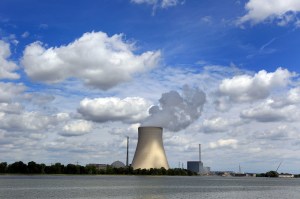
The cooling tower of a nuclear power plant
Even if you love nuclear power (gee whiz, it’s carbon free!), you have to admit there’s a problem with using the energy that binds atoms as a source to power cities: nuclear waste. Fission produces isotopes that remain radioactive for thousands of years. And no one wants the waste anywhere near them. In December, the U.S. Nuclear Regulatory Commission (NRC) kicked the proverbial nuclear-waste cask further down the road when it released a new policy stating that waste can be safely stored on-site at nuclear power plants for 60 years after a reactor goes out of service.
Now it’s being sued by the attorneys general of New York, Connecticut and Vermont over concerns that this new policy could pose a health risk to nearby residents, drive down property prices, and blight neighborhoods.
See how complicated the waste issue can be?
The three states feel that the NRC’s blanket policy violates federal laws that require an environmental assessment to be carried out at each nuclear site before mid to long-term storage of waste is approved. “A prudent federal response to the problem of spent fuel storage might be different form one site to the next,” Vermont’s Attorney General William Sorrell told the New York Times. “That’s what this is about.”
(More on TIME.com: See pictures of the death of an ageing nuclear power plant)
Well, maybe. It’s also about the nimbyism that always surrounds nuclear waste. The Obama administration has promoted nuclear power as a key tool to combat climate change, but simultaneously failed to find a long-term storage site for waste (Obama ruled out using underground storage at Yucca Mountain in Nevada in 2009, though state utility regulators are challenging that decision). No one wants radioactive fuel in their backyard, as New York Attorney General Eric Schneiderman made clear in a prepared statement announcing the lawsuit against the NRC: “This is not just a safety and environmental issue, but also one that could affect property values in Westchester, and I am committed to forcing the feds to take the hardest look possible at the risks of long-term, on site storage, before they allow our communities to become blighted…”
Schneiderman, a Democrat, is particularly concerned about the Indian Point power plant, which sits on the bank of the Hudson River about 25 miles north of New York City. Indian Point, like most mature power plants, no longer has room to store radioactive “spent fuel” in a special pool designed for that purpose. As a result, it uses dry “casks” into which spent fuel rods are sealed. The 15 casks at Indian Point hold around 96,000 fuel rods. There are currently two nuclear power reactors in operation in Connecticut (Millstone units 2 and 3) as well as two shut down units (Millstone unit 1 and the single-unit Connecticut Yankee plant) with such casks. The Vermont Yankee plant also will need to store spent fuel on-site.
A spokesman for the NRC told the New York Times that the lawsuits “mischaracterized the nature” of the NRC’s December decision. He described it as a commission ‘opinion’ on how long waste could be safely stored rather than a formal ruling, although the spokesman acknowledged that an environmental-impact statement now does not need to be prepared before the NRC grants an extension to on-site storage of casks.
Whether an opinion or a ruling, the NRC’s decision emboldened nuclear’s supporters when it came down in December by promising a mid-range plan for handling nuclear waste, which in turn might help strengthen planning applications and reassure investors in new power plants. But as the current lawsuit shows, the problem of nuclear waste—just like the waste itself—doesn’t go away easily.
(More on TIME.com: See pictures of the world’s worst nuclear disasters)


